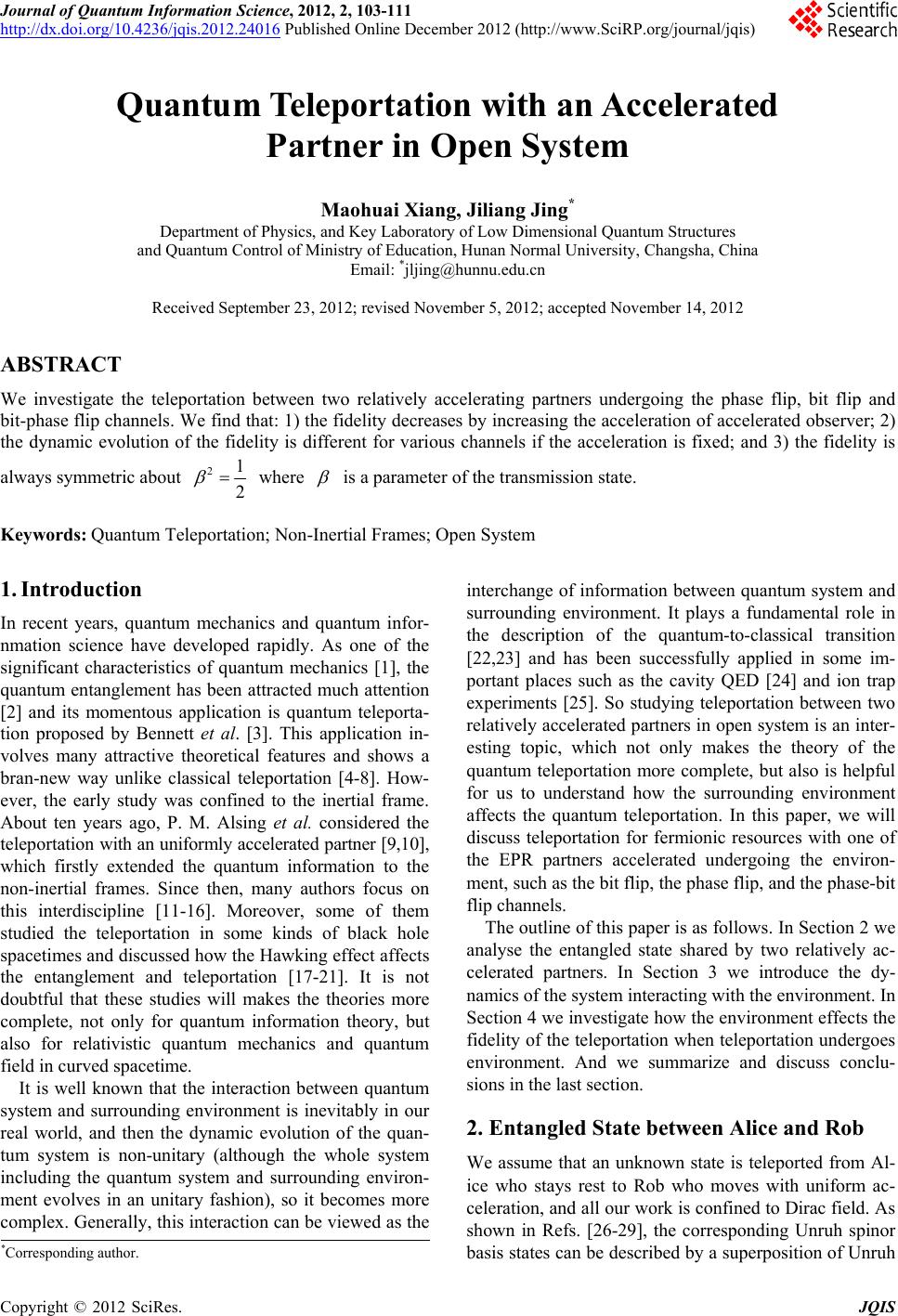 Journal of Quantum Information Science, 2012, 2, 103-111 http://dx.doi.org/10.4236/jqis.2012.24016 Published Online December 2012 (http://www.SciRP.org/journal/jqis) Quantum Teleportation with an Accelerated Partner in Open System Maohuai Xiang, Jiliang Jing* Department of Physics, and Key Laboratory of Low Dimensional Quantum Structures and Quantum Control of Ministry of Education, Hunan Normal University, Changsha, China Email: *jljing@hunnu.edu.cn Received September 23, 2012; revised November 5, 2012; accepted November 14, 2012 ABSTRACT We investigate the teleportation between two relatively accelerating partners undergoing the phase flip, bit flip and bit-phase flip channels. We find that: 1) the fidelity decreases by increasing the acceleration of accelerated observer; 2) the dynamic evolution of the fidelity is different for various channels if the acceleration is fixed; and 3) the fidelity is always symmetric about 21 2 where is a parameter of the transmission state. Keywords: Quantum Teleportation; Non-Inertial Frames; Open System 1. Introduction In recent years, quantum mechanics and quantum infor- nmation science have developed rapidly. As one of the significant characteristics of quantum mechanics [1], the quantum entanglement has been attracted much attention [2] and its momentous application is quantum teleporta- tion proposed by Bennett et al. [3]. This application in- volves many attractive theoretical features and shows a bran-new way unlike classical teleportation [4-8]. How- ever, the early study was confined to the inertial frame. About ten years ago, P. M. Alsing et al. considered the teleportation with an uniformly accelerated partner [9,10], which firstly extended the quantum information to the non-inertial frames. Since then, many authors focus on this interdiscipline [11-16]. Moreover, some of them studied the teleportation in some kinds of black hole spacetimes and discussed how the Hawking effect affects the entanglement and teleportation [17-21]. It is not doubtful that these studies will makes the theories more complete, not only for quantum information theory, but also for relativistic quantum mechanics and quantum field in curved spacetime. It is well known that the interaction between quantum system and surrounding environment is inevitably in our real world, and then the dynamic evolution of the quan- tum system is non-unitary (although the whole system including the quantum system and surrounding environ- ment evolves in an unitary fashion), so it becomes more complex. Generally, this interaction can be viewed as the interchange of information between quantum system and surrounding environment. It plays a fundamental role in the description of the quantum-to-classical transition [22,23] and has been successfully applied in some im- portant places such as the cavity QED [24] and ion trap experiments [25]. So studying teleportation between two relatively accelerated partners in open system is an inter- esting topic, which not only makes the theory of the quantum teleportation more complete, but also is helpful for us to understand how the surrounding environment affects the quantum teleportation. In this paper, we will discuss teleportation for fermionic resources with one of the EPR partners accelerated undergoing the environ- ment, such as the bit flip, the phase flip, and the phase-bit flip channels. The outline of this paper is as follows. In Section 2 we analyse the entangled state shared by two relatively ac- celerated partners. In Section 3 we introduce the dy- namics of the system interacting with the environment. In Section 4 we investigate how the environment effects the fidelity of the teleportation when teleportation undergoes environment. And we summarize and discuss conclu- sions in the last section. 2. Entangled State between Alice and Rob We assume that an unknown state is teleported from Al- ice who stays rest to Rob who moves with uniform ac- celeration, and all our work is confined to Dirac field. As shown in Refs. [26-29], the corresponding Unruh spinor basis states can be described by a superposition of Unruh *Corresponding author. C opyright © 2012 SciRes. JQIS 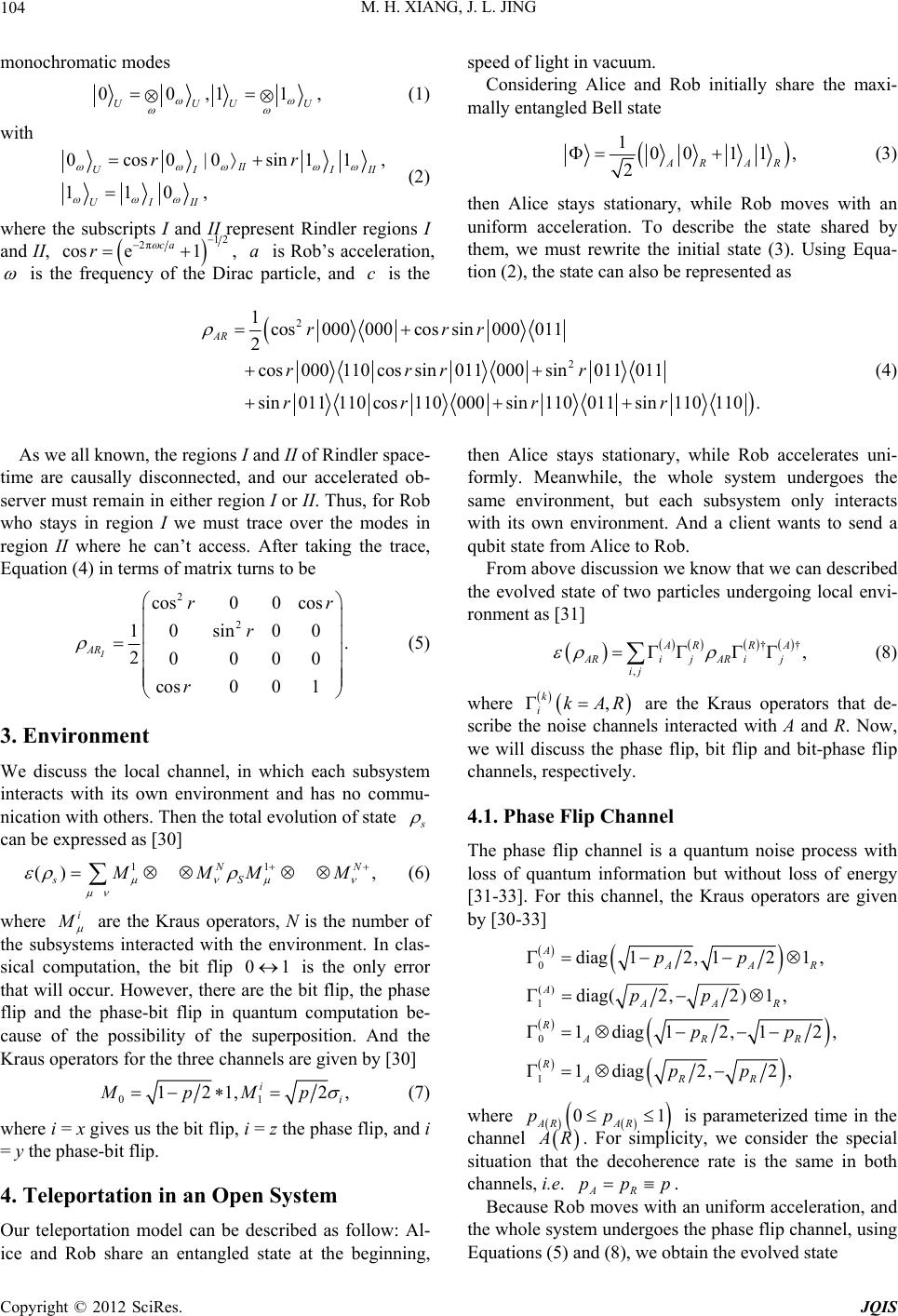 M. H. XIANG, J. L. JING 104 monochromatic modes 00,11 UU U , U (1) with 0cos0|0sin11 110, II UI I UIII rr , II (2) where the subscripts I and II represent Rindler regions I and II, speed of light in vacuum. Considering Alice and Rob initially share the maxi- mally entangled Bell state 100 11, 2AR AR (3) then Alice stays stationary, while Rob moves with an uniform acceleration. To describe the state shared by them, we must rewrite the initial state (3). Using Equa- tion (2), the state can also be represented as 12 2π cos e1 ca r , is Rob’s acceleration, a is the frequency of the Dirac particle, and is the c 2 2 1cos000 000cossin000 011 2 cos000110cossin011 000sin011 011 sin011110cos110 000sin110 011sin110110. AR rrr rrr r rrr r (4) As we all known, the regions I and II of Rindler space- time are causally disconnected, and our accelerated ob- server must remain in either region I or II. Thus, for Rob who stays in region I we must trace over the modes in region II where he can’t access. After taking the trace, Equation (4) in terms of matrix turns to be 2 2 cos00 cos 0sin 00 1. 20000 cos00 1 I AR rr r r (5) 3. Environment We discuss the local channel, in which each subsystem interacts with its own environment and has no commu- nication with others. Then the total evolution of state can be expressed as [30] 11 () , N sS MMM M N (6) where i are the Kraus operators, N is the number of the subsystems interacted with the environment. In clas- sical computation, the bit flip is the only error that will occur. However, there are the bit flip, the phase flip and the phase-bit flip in quantum computation be- cause of the possibility of the superposition. And the Kraus operators for the three channels are given by [30] 01 01 121, 2 i i MpMp, (7) where i = x gives us the bit flip, i = z the phase flip, and i = y the phase-bit flip. 4. Teleportation in an Open System Our teleportation model can be described as follow: Al- ice and Rob share an entangled state at the beginning, then Alice stays stationary, while Rob accelerates uni- formly. Meanwhile, the whole system undergoes the same environment, but each subsystem only interacts with its own environment. And a client wants to send a qubit state from Alice to Rob. From above discussion we know that we can described the evolved state of two particles undergoing local envi- ronment as [31] †† , , ARR A ARijAR ij ij (8) where are the Kraus operators that de- scribe the noise channels interacted with A and R. Now, we will discuss the phase flip, bit flip and bit-phase flip channels, respectively. , k ikAR 4.1. Phase Flip Channel The phase flip channel is a quantum noise process with loss of quantum information but without loss of energy [31-33]. For this channel, the Kraus operators are given by [30-33] 0 () 1 0 1 diag12,121 , diag(2,2)1 , 1diag12,1 2 1diag2,2, A AA A AAR R AR R ARR pp pp pp pp , R R where 0 AR AR pp1 is parameterized time in the channel R pp . For simplicity, we consider the special situation that the decoherence rate is the same in both channels, i.e. AR p . Because Rob moves with an uniform acceleration, and the whole system undergoes the phase flip channel, using Equations (5) and (8), we obtain the evolved state Copyright © 2012 SciRes. JQIS 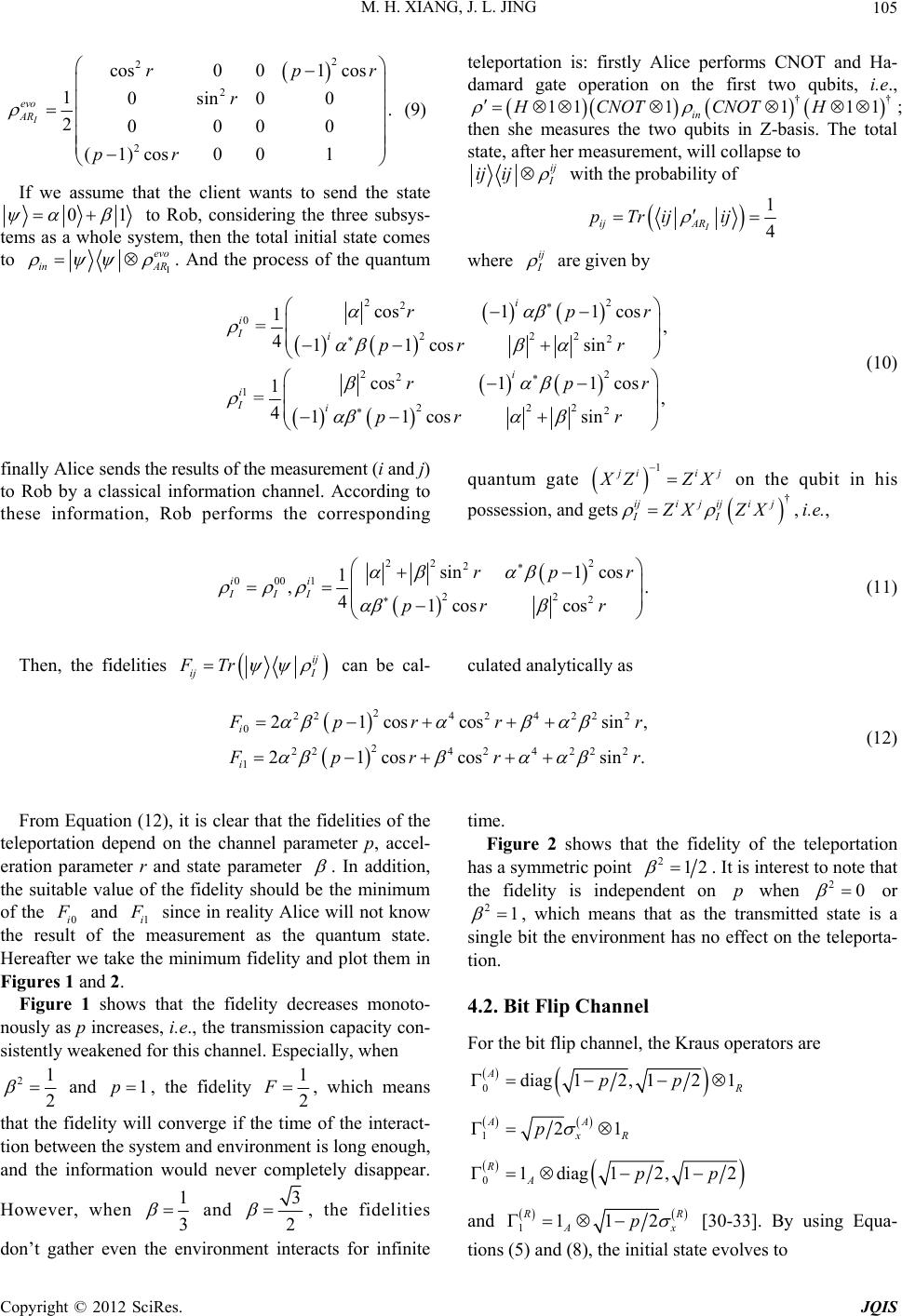 M. H. XIANG, J. L. JING 105 2 2 2 2 cos001 cos 10sin00 . 20000 (1)cos0 01 I evo AR rp r pr r (9) If we assume that the client wants to send the state 0 teleportation is: firstly Alice performs CNOT and Ha- damard gate operation on the first two qubits, i.e., ; then she measures the two qubits in Z-basis. The total state, after her measurement, will collapse to †† 1111 11 in HCNOTCNOT H ij ij ij with the probability of 1 4 I ij AR pTrij ij 1 to Rob, considering the three subsys- tems as a whole system, then the total initial state comes to evo in AR . And the process of the quantum where ij are given by 22 2 0 22 22 2 2 1 22 22 cos11 cos 1 =, 411cos sin cos11 cos 1 =, 411cossin i i Ii i i Ii rp pr r rp pr r 2 r r (10) finally Alice sends the results of the measurement (i and j) to Rob by a classical information channel. According to these information, Rob performs the corresponding quantum gate 1 iij ZZ ijij ij X on the qubit in his possession, and getsi.e., †, i j II ZX ZX 22 2 2 0001 2 22 sin1 cos 1 ,. 41coscos ii III rp pr r r (11) Then, the fidelities ij ij I FTr can be cal- culated analytically as 2 2242422 2 0 2 2242422 2 1 21coscos si 21coscos sin i i n, . pr rr pr r r (12) From Equation (12), it is clear that the fidelities of the teleportation depend on the channel parameter p, accel- eration parameter r and state parameter . In addition, the suitable value of the fidelity should be the minimum of the 0i and 1i since in reality Alice will not know the result of the measurement as the quantum state. Hereafter we take the minimum fidelity and plot them in Figures 1 and 2. Figure 1 shows that the fidelity decreases monoto- nously as p increases, i.e., the transmission capacity con- sistently weakened for this channel. Especially, when 21 2 and , the fidelity 1p1 2 F, which means that the fidelity will converge if the time of the interact- tion between the system and environment is long enough, and the information would never completely disappear. However, when 1 3 and 3 2 , the fidelities don’t gather even the environment interacts for infinite time. Figure 2 shows that the fidelity of the teleportation has a symmetric point 212 . It is interest to note that the fidelity is independent on when p20 or 21 , which means that as the transmitted state is a single bit the environment has no effect on the teleporta- tion. 4.2. Bit Flip Channel For the bit flip channel, the Kraus operators are 0diag12, 121 A pp 121 AA R p 01diag12,12 R App and 1112 R A px [30-33]. By using Equa- tions (5) and (8), the initial state evolves to Copyright © 2012 SciRes. JQIS  M. H. XIANG, J. L. JING 106 1.0 0.9 0.8 0.7 0.6 0.5 F 0.0 0.2 0.4 0.6 0.8 1.0 r = 0 r =π/8 r =π/4 r = 0 r =π/8 r =π/4 r = 0 r =π/8 r =π/4 1.0 0.9 0.8 0.7 0.6 0.5 F 1.0 0.9 0.8 0.7 0.6 0.5 F 0.0 0.2 0.4 0.6 0.8 1.0 0.0 0.2 0.4 0.6 0.8 1.0 (a) (b) (c) Figure 1. Fidelity as a function of with some fixed acceleration parameters p 0r (blue curve), π8r (red curve) and π4r (green curve), and initial state parameters 1 2 β (left), 1 3 β (middle), 3 2 β (right) when the system under the phase flip channel. 1.0 0.9 0.8 0.7 0.6 0.5 F 0.0 0.2 0.4 0.6 0.8 1.0 r = 0 r =π/8 r =π/4 r = 0 r =π/8 r =π/4 r = 0 r =π/8 r =π/4 1.0 0.9 0.8 0.7 0.6 0.5 F 1.0 0.9 0.8 0.7 0.6 0.5 F 0.0 0.2 0.4 0.6 0.8 1.0 0.0 0.2 0.4 0.6 0.8 1.0 β2 β2 β2 (a) (b) (c) Figure 2. Fidelity as a function of 2 with some fixed acceleration parameters 0r (blue curve), π8r (red curve) and π4r (green curve) when (left), =0p=1 2 p (middle) and (right) as the system under the phase flip chan- nel. =1p 1 2 3 4 10022 2 1 02cos 12, 1 402cos 0 2 1 22cos 002 I evo AR Bp Bppr pp rB pp rB cos 0 pr 2 r 2r (13) with 12123cosBpppp 221 1cos2Bp ppr 331cos2Bpppr and . 443 1cosBpppp Analogous analysis as the subsection A, Rob obtains the state ij 22 013 22 42 4cos 1, 44cos i I BB r rB B (14) or 22 142 22 13 4cos 1. 44cos i I BB r rB B (15) Then the fidelities ij are 224 4 02341 224 4 12341 18, 4 18. 4 i i FBBBB FBBBB (16) We plot the fidelity in Figures 3 and 4. From Figure 3, we know that when 21 2 the fidelity is independent on the environment Copyright © 2012 SciRes. JQIS 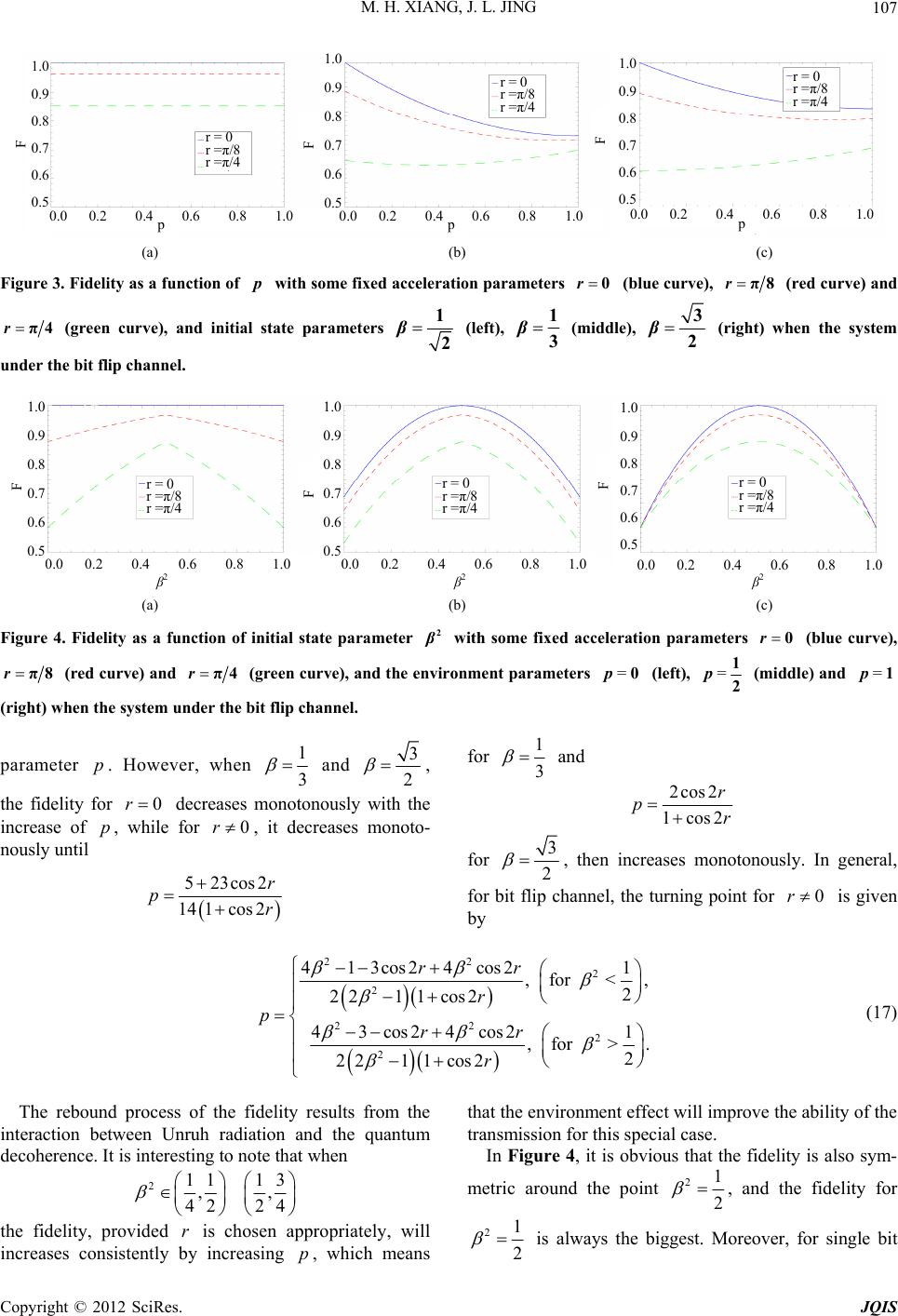 M. H. XIANG, J. L. JING 107 1.0 1.0 0.9 0.8 0.7 0.6 0.5 0.9 0.8 0.7 0.6 0.5 F 0.0 0.2 0.4 0.6 0.8 1.0 1.0 0.9 0.8 0.7 0.6 0.5 r = 0 r =π/8 r =π/4 r = 0 r =π/8 r =π/4 r = 0 r =π/8 r =π/4 F F 0.0 0.2 0.4 0.6 0.8 1.0 0.0 0.2 0.4 0.6 0.8 1.0 p pp (a) (b) (c) Figure 3. Fidelity as a function of with some fixed acceleration parameters 0r (blue curve), π8r (red curve) an d π4r (green curve), and initiatate parameters l s1 2 β (left), 1 3 β (middle), 3 2 β (rwhen the system he bit flip channel. ight) under t 1.0 0.9 0.8 0.7 0.6 0.5 F 0.0 0.2 0.4 0.6 0.8 1.0 r = 0 r =π/8 r =π/4 r = 0 r =π/8 r =π/4 r = 0 r =π/8 r =π/4 1.0 0.9 0.8 0.7 0.6 0.5 F 1.0 0.9 0.8 0.7 0.6 0.5 F 0.0 0.2 0.4 0.6 0.8 1.0 0.0 0.2 0.4 0.6 0.8 1.0 β2 β2 β2 (a) (b) (c) Figure 4. Fidelity as a function of initial state parameter 2 w ith some fixed acceleration parameters (blue curve), 0r π8r (red curve) and π4r (green curve), and the enronment parameters =0p (left), vi =1 2 p (mie) and =1p hen the system undit flip channel. arameter p. However, when ddl (right) wer the b p1 and 3 2 3, fo onotowith ththe fidelity r 0r decreases mnously e increase of , while for 0rp , reases m- it deconoto nously until 52 s2r 1 3 and 3co 141cos 2 pr for 2cos2 1cos2 r pr for 3 2 , then increases monoously. In general, it flip c ton for bhannel, the turning point for 0r is given by 22 2 2 22 2 2 413cos24cos2 1 , for <, 2 221 1cos2 43cos24cos21 , for >. 2 221 1cos2 rr r prr r (17) The rebound process of the fidelity results from the teraction between Unruh radiation and the quantum e in dcoherence. It is interesting to note that when 21113 ,, 42 24 the fidelity, provided is chosen appropriately, will increases consistently by increasing , which means that the environment effect will improve the ability of the transmission for this special case. In Figure 4, it is obvious that the fidelity is also sym- metric around the point r p 21 2 , and the fidelity for 21 2 is always the biggest. Moreov r, for single bit e Copyright © 2012 SciRes. JQIS 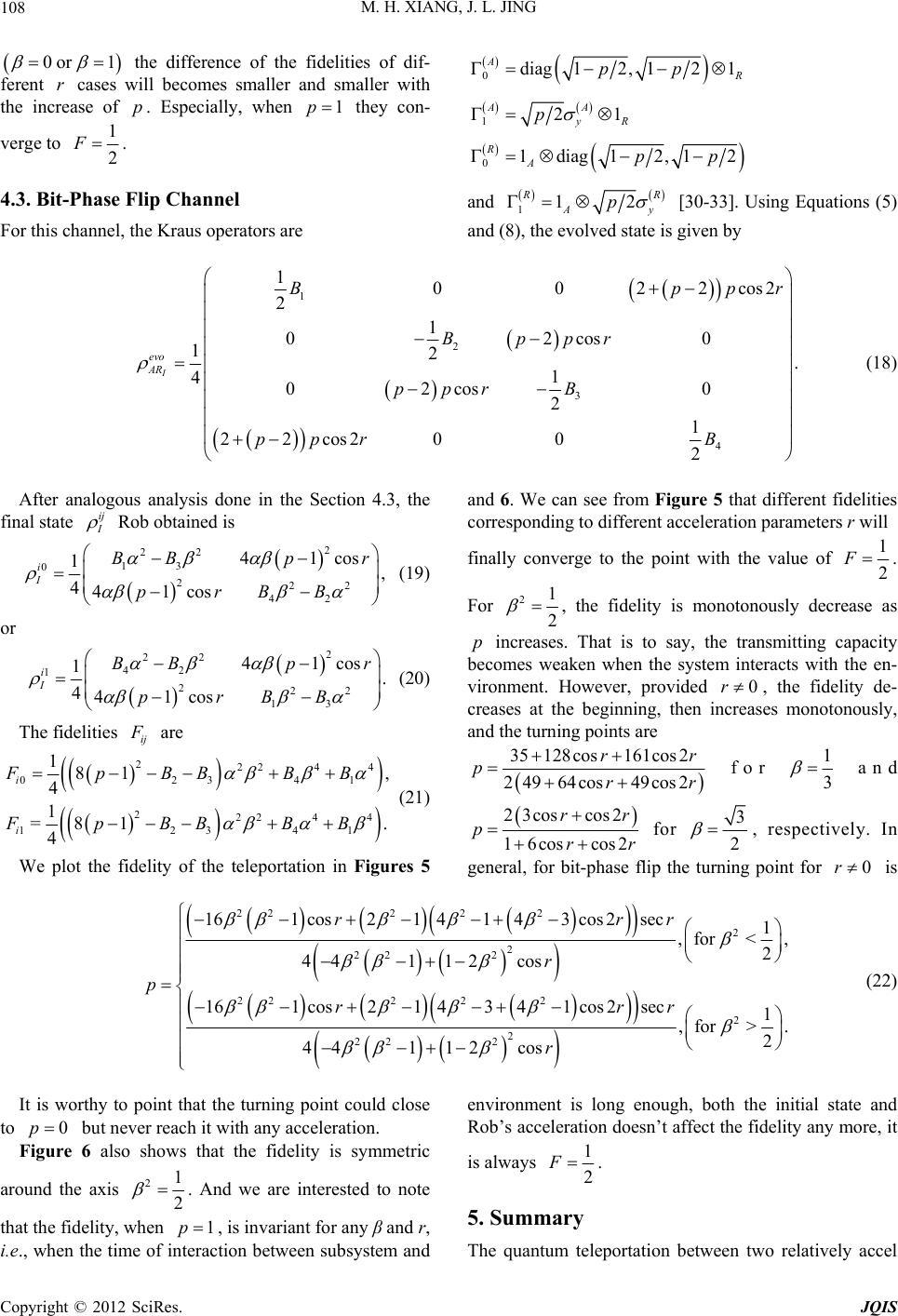 M. H. XIANG, J. L. JING 108 0or 1 the difference of the fidelities of dif- ferent r cases will becomes smaller and smaller with the increase of p. Especially, when 1p they con- verge to 1 F. 2 4.3. Bit-Phase Flip Channel For this channel, the Kraus operators are 0diag12, 12 A1 pp 121 AA R p 01diag12,12 R App 112 R Ay p and [30-33]. Using Equations (5) and (8), the evolved state is given by 1 2 3 4 02 2 1 02cos0 12. 1 402cos 0 2 1 22cos2 002 I evo AR Bpr Bppr pprB pprB (18) After analogous analysis done in the Section 4.3, the final state 1 022cosp ij Rob obtained is 222 42 , 441 cos Ipr BB (19) 2 22 13 041cos 1BBp r or i 2 22 42 1 222 13 41cos 1. 441cos i I BBp r prBB (20) The fidelities ij are 12 1 =8 1 ip BB 2224 4 02341 2224 4 341 181 4 . 4 i FpBBBB F BB , (21) We plot the fidelity of the teleportation in Figures 5 and 6. We can see from Figure 5 that different fidelities corresponding to different acceleration parameters r will finally converge to the point with the value of 1 2 F . For 21 2 , the fidelity is monotonously decrease as ment. an p increases. That is to say, the transmitting capacity becomes weaken when the system interacts with the en- vironHowever, provided 0r, the fidelity de- creases at the beginning, then increases monotonously, d the turning points are 35128cos161cos 2 24964cos49cos 2 rr prr r fo1 3 and 23cos cos2rr p for 3 2 rning point0 16 cos cos2 rr , respectively. In general, for bit-phase flip the tu for r is 22222 2 2 2 sec 1 ,f or <, 2 2 cos r r 22 44 1 1 22 2 22 2 2 22 2 161cos2 14 143cos2 161cos214341cos2sec1 ,for >. 2 441 12cos rr p rrr r (22) It is worthy to point that the turning point could close to but never reach it with any acceleration. Figure 6 also shows that the fidelity is symmetric ar 0p ound the axis 21 2 . And we are interested to note that th i.e environment is long enough, both the initial state and Rob’s acceleration doesn’t affect the fidelity any more, it is always e fidelity, when 1p, is invariant for any β and r, ., when the time of interaction between subsystem and 1 2 F . 5. Summary The quantum teleportaetween two relatively accel tion b Copyright © 2012 SciRes. JQIS 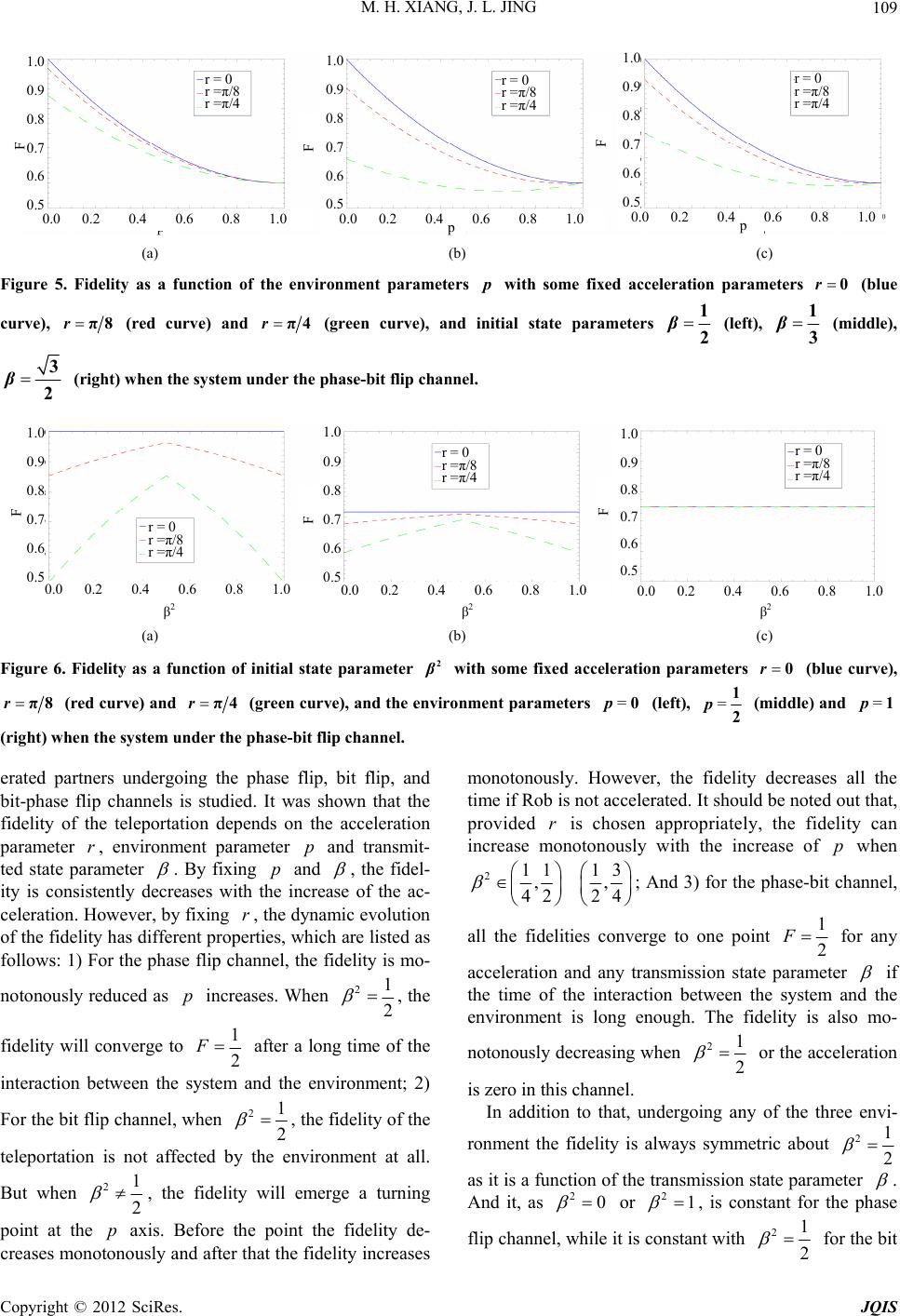 M. H. XIANG, J. L. JING 109 1.0 0.9 0.8 0.7 0.6 0.5 F r = 0 r =π/8 r =π/4 r = 0 r =π/8 r =π/4 r = 0 r =π/8 r =π/4 1.0 0.8 0.7 0.6 0.5 0.9 1.0 0.9 0.8 0.7 0.6 0.5 F F 0.0 0.2 0.4 0.6 0.8 1.0 p 0.0 0.2 0.4 0.6 0.8 1.0 p p 0.0 0.2 0.4 0.6 0.8 1.0 (a) (b) (c) Figure 5. Fidelity as a function of the environment parameterswith some fixed acceleration parameters p 0r (blue curve), π8r (left), 1 3 (mi (green curve), anditial state parameters in 1 2 β (red curve) and π4rβddle), 3 2 β (right) when the system under the phase-bit flip channel. 1.0 0.8 0.9 0.7 0.6 0.5 F 0.0 0.2 0.4 0.6 0.8 1.0 r = 0 r =π/8 r =π/4 r = 0 r =π/8 r =π/4 r = 0 r =π/8 r =π/4 1.0 1.0 0.9 0.8 0.7 0.6 0.5 0.9 0.8 0.7 0.6 0.5 F F 0.0 0.2 0.4 0.6 0.8 1.0 0.0 0.2 0.4 0.6 0.8 1.0 β2 β2 β2 (a) (b) (c) Figure 6. Fidelity as a function of initial state parameter 2 with some fixed acceleration parameters (blue curve), 0r π8r (green curve), and theronment parameters (left), envi=0p=1 2 p (middl(red curve) and π4r e) and (right) when the sys bit-phase flip channels is studied. It was shown that the fidelityion de it- =1p tem under the phase-bit flip channel. erated partners undergoing the phase flip, bit flip, and of the teleportatpends on the acceleration parameter r, environment parameter p and transm d state parameter te . By fixing p and , the fidel- F e ity is consistently decreases with the increase of the ac- celeration. However, by fixing r, the dynamic evolution of the fidelity has different properties, which are listed as follows: 1) or the phase flip channel, th fidelity is mo- notonously reduced as p increases. When 21 2 , the fidelity will converge to 1 2 F after a long time of the interaction between the system and the environment; 2) For the bit flip channel, when 21 , the fidf the teleportation is not affec the environment at all. 2elity o ted by But when 21 2 , the fidelity will emerge a turning point at the p axis. Before nt the fidelity de- creases monotonously and after increases the poi that the fidelity d be n hosenriate can increase monotonously with the increase of when monotonously. However, the fidelity decreases all the time if Rob is not accelerated. It shouloted out that, provided r is c approply, the fidelity p 21113 ,, 42 24 ; And 3) for the phase-bit channel, ities coall the fidelnverge to one point 1 F for any 2 acceleration and any transmission state parameter if the time of the interaction between the system and the environment is long enough. The fidelity is also mo- notonouslydecreasing when 21 2 or the acceleration is zero in this channel. In addition to that, ronment the fidelity is always symmetric about undergoing any of the three envi- 21 2 as it is a function of the transmission state parameter . And it, as 20 or 21 , is constant for the pse flip channel, while it is constant with ha 21 for the bit 2 Copyright © 2012 SciRes. JQIS 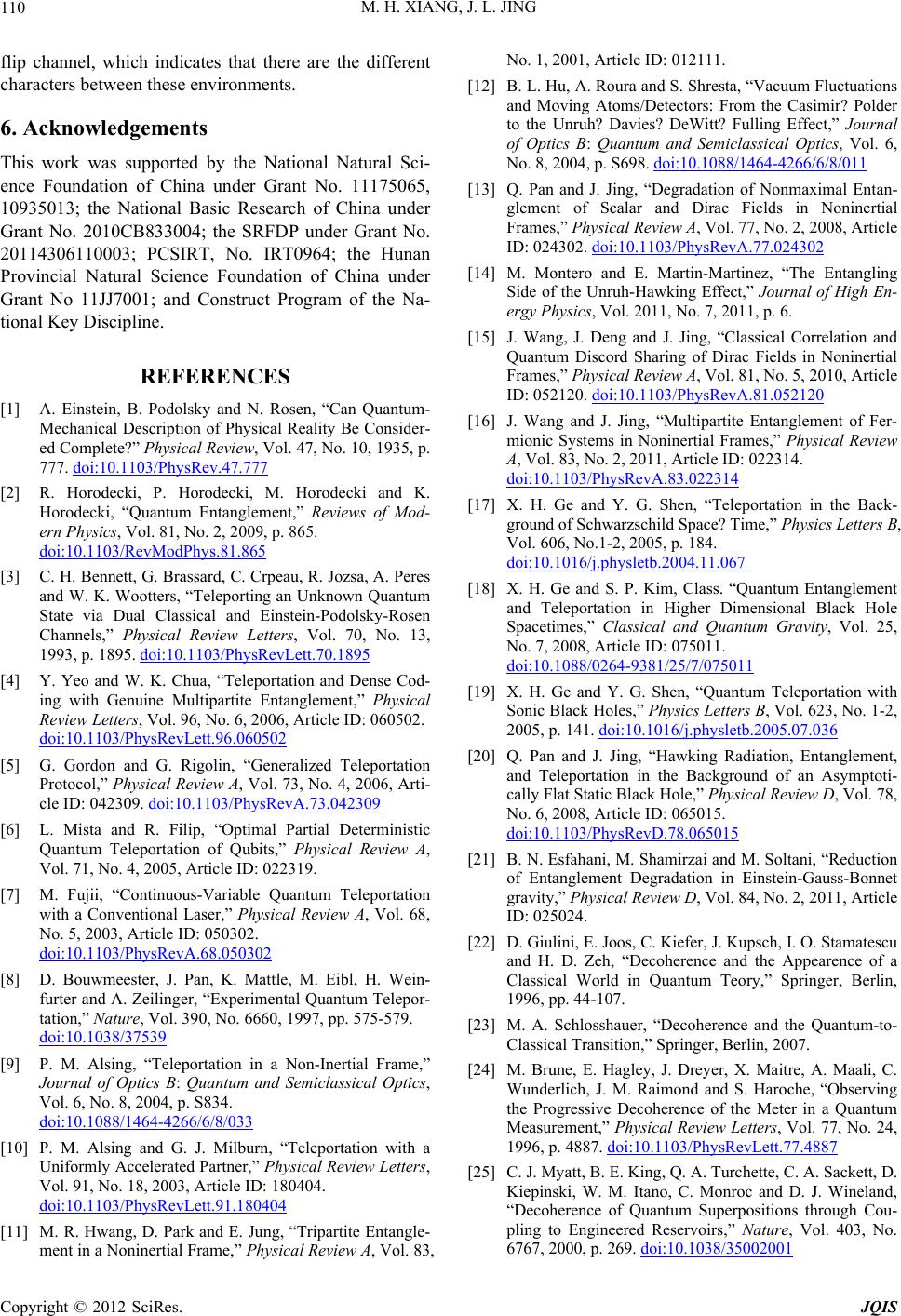 M. H. XIANG, J. L. JING 110 flip channel, which indicates that there are the different characters between these environments. nts Th 75065 10935013; the National Basic Research of China 0003; PCSIRT, n of C ogram of t NCES 6. Acknowledgeme is work was supported by the National Natural Sci- ence Foundation of China under Grant No. 111, under Grant No. 2010CB833004; the SRFDP under Grant No. 2011430611No. IRT0964; the Hunan Provincial Natural Science Foundatiohina under Grant No 11JJ7001; and Construct Prhe Na- tional Key Discipline. REFERE [1] A. Einstein, B. Podolsky and N. Rosen, “Can Quantum- Mechanical Description of Physical Reality Be Consider- ed Complete?” Physical Review, Vol. 47, No. 10, 1935, p. 777. doi:10.1103/PhysRev.47.777 [2] R. Horodecki, P. Horodecki, M. Horodecki and K. Horodecki, “Quantum Entanglement,” Reviews of Mod- ern Physics, Vol. 81, No. 2, 2009, p. 865. doi:10.1103/RevModPhys.81.865 [3] C. H. Bennett, G. B and W. K. Wootters, “Tel rassard, C. Crpeau, R. Jozsa, A. Peres eporting an Unknown Quantum State via Dual Classical and Einstein-Podolsky- Channels,” Ph Rosen ysical Review Letters, Vol. 70, No. 13, 1993, p. 1895. doi:10.1103/PhysRevLett.70.1895 [4] Y. Yeo and W. K. Chua, “Teleportation and Dense Cod- ing with Genuine Multipartite Entanglement,” Physical Review Letters, Vol. 96, No. 6, 2006, Article ID: 060502. doi:10.1103/PhysRevLett.96.060502 [5] G. Gordon and G. Rigolin, “Generalized Teleportation Protocol,” Physical Review A, Vol. 73, No. 4, 2006, Arti- cle ID: 042309. doi:10.1103/PhysRevA.73.042309 ol. 68 [6] L. Mista and R. Filip, “Optimal Partial Deterministic Quantum Teleportation of Qubits,” Physical Review A, Vol. 71, No. 4, 2005, Article ID: 022319. [7] M. Fujii, “Continuous-Variable Quantum Teleportation with a Conventional Laser,” Physical Review A, V, No. 5, 2003, Article ID: 050302. doi:10.1103/PhysRevA.68.050302 [8] D. Bouwmeester, J. Pan, K. Mattle, M. Eibl, H. Wein- furter and A. Zeilinger, “Experimental Quantum Telepor- tation,” Nature, Vol. 390, No. 6660, 1997, pp. 575-579. doi:10.1038/37539 [9] P. M. Alsing, “Teleportation in a Non-Inertial Frame,” Journal of Optics B: Quantum and Semiclassical Optics, Vol. 6, No. 8, 2004, p. S834. doi:10.1088/1464-4266/6/8/033 [10] P. M. Alsing and G. J. Milburn, “Teleportation with a Uniformly Accelerated Partner,” Physical Review Letters, Vol. 91, No. 18, 2003, Article ID: 180404. doi:10.1103/PhysRevLett.91.180404 Detectors: From the Casimir? Polder 88/1464-4266/6/8/011 [11] M. R. Hwang, D. Park and E. Jung, “Tripartite Entangle- ment in a Noninertial Frame,” Physical Review A, Vol. 83, No. 1, 2001, Article ID: 012111. [12] B. L. Hu, A. Roura and S. Shresta, “Vacuum Fluctuations and Moving Atoms/ to the Unruh? Davies? DeWitt? Fulling Effect,” Journal of Optics B: Quantum and Semiclassical Optics, Vol. 6, No. 8, 2004, p. S698. doi:10.10 Entan- 2 [13] Q. Pan and J. Jing, “Degradation of Nonmaximal glement of Scalar and Dirac Fields in Noninertial Frames,” Physical Review A, Vol. 77, No. 2, 2008, Article ID: 024302. doi:10.1103/PhysRevA.77.02430 z, “The Entangling ssical Correlation and [14] M. Montero and E. Martin-Martine Side of the Unruh-Hawking Effect,” Journal of High En- ergy Physics, Vol. 2011, No. 7, 2011, p. 6. [15] J. Wang, J. Deng and J. Jing, “Cla Quantum Discord Sharing of Dirac Fields in Noninertial Frames,” Physical Review A, Vol. 81, No. 5, 2010, Article ID: 052120. doi:10.1103/PhysRevA.81.052120 [16] J. Wang and J. Jing, “Multipartite Entanglement of Fer- mionic Systems in Noninertial Frames,” Physical Review A, Vol. 83, No. 2, 2011, Article ID: 022314. doi:10.1103/PhysRevA.83.022314 [17] X. H. Ge and Y. G. Shen, “Teleportation in the Back- ground of Schwarzschild Space? Time,” Physics Letters B, Vol. 606, No.1-2, 2005, p. 184. doi:10.1016/j.physletb.2004.11.067 [18] X. H. Ge and S. P. Kim, Class. “Quantum Entanglement and Teleportation in Higher Dimensional Black Hole Spacetimes,” Classical and Quantum Gravity, Vol. 25, No. 7, 2008, Article ID: 075011. doi:10.1088/0264-9381/25/7/075011 [19] X. H. Ge and Y. G. Shen, “Quantum Teleportation with Sonic Black Holes,” Physics Letters B, Vol. 623, No. 1-2, 2005, p. 141. doi:10.1016/j.physletb.2005.07.036 iation, Entanglement, [20] Q. Pan and J. Jing, “Hawking Rad and Teleportation in the Background of an Asymptoti- cally Flat Static Black Hole,” Physical Review D, Vol. 78, No. 6, 2008, Article ID: 065015. doi:10.1103/PhysRevD.78.065015 [21] B. N. Esfahani, M. Shamirzai and M. Soltani, “Reduction of Entanglement Degradation in Einstein-Gauss-Bonnet gravity,” Physical Review D, Vol. 84, No. 2, 2011, Article ID: 025024. [22] D. Giulini, E. Joos, C. Kiefer, J. Kupsch, I. O. Stamatescu . Haroche, “Observing Meter in a Quantum and H. D. Zeh, “Decoherence and the Appearence of a Classical World in Quantum Teory,” Springer, Berlin, 1996, pp. 44-107. [23] M. A. Schlosshauer, “Decoherence and the Quantum-to- Classical Transition,” Springer, Berlin, 2007. [24] M. Brune, E. Hagley, J. Dreyer, X. Maitre, A. Maali, C. Wunderlich, J. M. Raimond and S the Progressive Decoherence of the Measurement,” Physical Review Letters, Vol. 77, No. 24, 1996, p. 4887. doi:10.1103/PhysRevLett.77.4887 [25] C. J. Myatt, B. E. King, Q. A. Turchette, C. A. Sackett, D. Kiepinski, W. M. Itano, C. Monroc and D. J. Wineland, “Decoherence of Quantum Superpositions through Cou- pling to Engineered Reservoirs,” Nature, Vol. 403, No. 6767, 2000, p. 269. doi:10.1038/35002001 Copyright © 2012 SciRes. JQIS 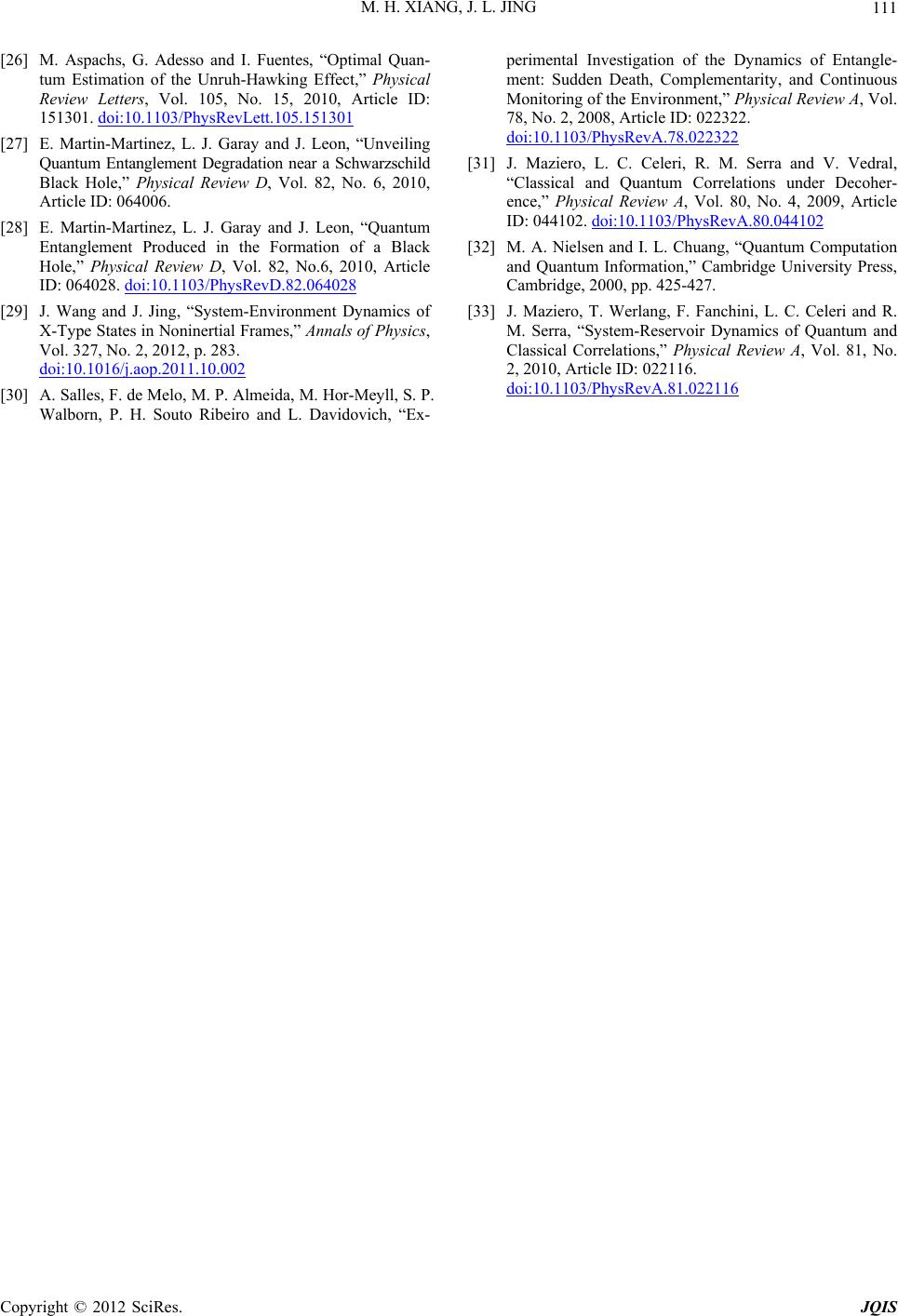 M. H. XIANG, J. L. JING Copyright © 2012 SciRes. JQIS 111 desso and I. Fuentes, “Optimal Quan-[26] M. Aspachs, G. A tum Estimation of the Unruh-Hawking Effect,” Physical Review Letters, Vol. 105, No. 15, 2010, Article ID: 151301. doi:10.1103/PhysRevLett.105.151301 [27] E. Martin-Martinez, L. J. Garay and J. Leon, “Unveiling Quantum Entanglement Degradation near a Schwarzschild Black Hole,” Physical Review D, Vol. 82, No. 6, 2010, Article ID: 064006. [28] E. Martin-Martinez, L. J. Garay and J. Leon, “Quantum Entanglement Produced in the Formation of a Black Hole,” Physical Review D, Vol. 82, No.6, 2010, Article ID: 064028. doi:10.1103/PhysRevD.82.064028 [29] J. Wang and J. Jing, “System-Environment Dynamics of X-Type States in Noninertial Frames,” Annals of Physics, Vol. 327, No. 2, 2012, p. 283. doi:10.1016/j.aop.2011.10.002 [30] A. Salles, F. de Melo, M. P. Almeida, M. Hor-Meyl Entangle- 22 l, S. P. Walborn, P. H. Souto Ribeiro and L. Davidovich, “Ex- perimental Investigation of the Dynamics of ment: Sudden Death, Complementarity, and Continuous Monitoring of the Environment,” Physical Review A, Vol. 78, No. 2, 2008, Article ID: 022322. doi:10.1103/PhysRevA.78.0223 [31] J. Maziero, L. C. Celeri, R. M. Serra and V. Vedral, “Classical and Quantum Correlations under Decoher- ence,” Physical Review A, Vol. 80, No. 4, 2009, Article ID: 044102. doi:10.1103/PhysRevA.80.044102 [32] M. A. Nielsen and I. L. Chuang, “Quantum Computation and Quantum Information,” Cambridg Cambridge, 2000, pp. 425-427. e University Press, [33] J. Maziero, T. Werlang, F. Fanchini, L. C. Celeri and R. M. Serra, “System-Reservoir Dynamics of Quantum and Classical Correlations,” Physical Review A, Vol. 81, No. 2, 2010, Article ID: 022116. doi:10.1103/PhysRevA.81.022116
|